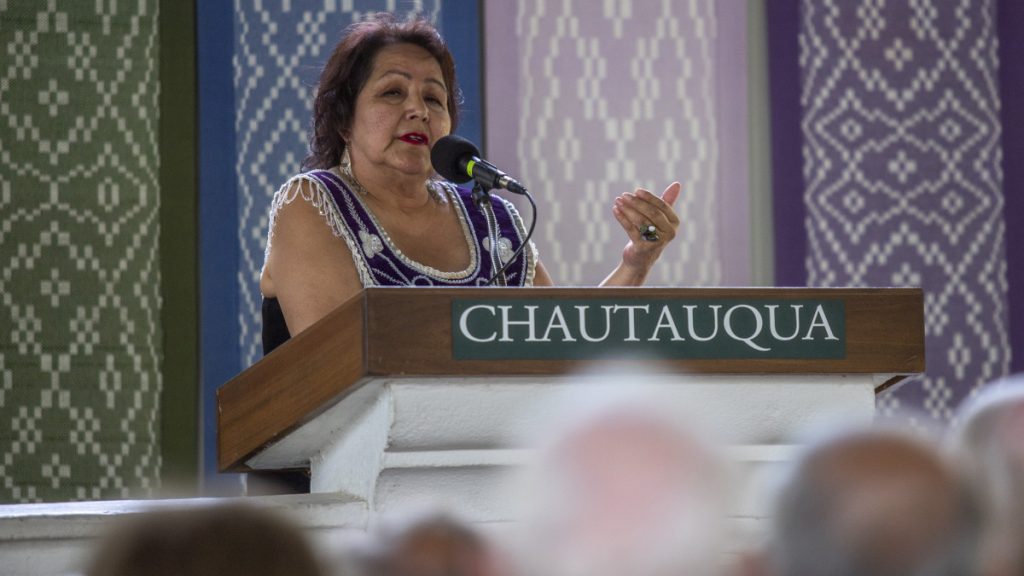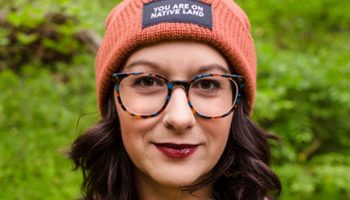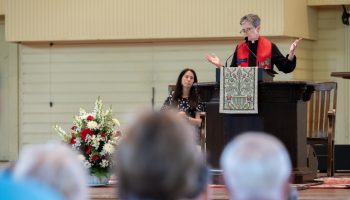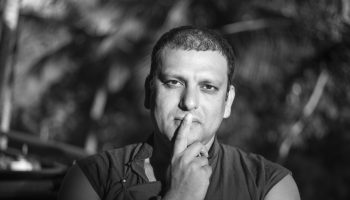Word-of-mouth history is the glue that binds one generation to the next in Indigenous cultures. These oral stories hold important records and lessons that were once only held in the minds of elders. They’re shared through the art of storytelling, but they will be lost if people are not willing to listen.
Diane Schenandoah, an artist and Faithkeeper in the Oneida Nation of the Wolf Clan of the Haudenosaunee Confederacy, spoke on Indigenous history during her lecture, “Our Journey of Being,” on Thursday, July 21, in the Hall of Philosophy as part of Week Four’s Interfaith Lecture Series theme “The Future of Being.”
Working over 30 years as a sculptor of clay and stone, Schenandoah is also a professional singer and writer. Her works, which are all rooted in her Indigenous culture, have won numerous awards and have been featured in galleries across America. She also serves as Syracuse University’s first-ever Honwadiyenawa’sek, which means “the one who helps them.”
In this role, Schenandoah shares her intuitive energy with the college community through holistic wellness programs, which include teachings of energy work, art therapy, tuning forks and self-empowerment.

“In my role as a Faithkeeper, it is my duty to share our teachings, and it is said that one day, our people will hear the messages of peace,” Schenandoah said. “… I want to share with you our history and our beginnings.”
Because Indigenous histories are passed down orally, there are several versions of these stories. Schenandoah, however, told the version that resonates with her the most.
In the Oneida Nation, it is believed that humans were born from the stars and evolved from starbeings. She told the story of the first woman on Turtle Island, a term some Indigenous people use to describe North America in reference to an Indigenous creation story.
“(The woman) came here, a sky woman, and gave birth to a female, and that was the beginning of our time here on this Earth,” Schenandoah said. “And as the Earth grew, our creator gave us certain instructions to live by.”
These instructions were simple: Love and care for one another and Mother Earth.
“As time went on, of course, the human ego began to get in the way — control issues, different types of issues, as human beings will — and we began to forget our original instructions,” Schenandoah said.
Prior to the formation of the Haudenosaunee Confederacy, the Mohawk, Oneida, Onondaga, Cayuga and Seneca nations had been plagued by violence against each other. Schenandoah described this dark time as “a great tug-of-war (of) killing and destruction.”
During this tumultuous era, there was an evil Onondaga chief by the name of Tadodaho.
“They say that (Tadodaho) tied snakes in his hair to scare people, to frighten them,” Schenandoah said. “And he killed … seven of (Hiawatha’s) daughters.”
Hiawatha was said to have spoken of peace at the end of war, spurring Tadodaho into so much anger that he killed his family.
“They said that Hiawatha was so grieved, so heartsick, he couldn’t function,” Schenandoah said. “… One day, he decided he just couldn’t take it anymore and … they say that he threw himself into this lake. And as he threw himself into this lake, they say that the geese came and lifted the water so he would be unable to drown himself.”
As Hiawatha was lifted, a purple quahog shell was revealed, which would later be used to create peace, or wampum, belts. The purple beads on the belts represent the bruising on the nations caused during the time of destruction, according to Schenandoah.
Hiawatha began stringing the beads together, to comfort himself and bring a sense of peace. With the beads he collected, he organized a healing ceremony in which he connected to nature and his inner emotions. Along with the beads, five symbols were collected to represent each nation, from an eagle feather ridding the dust of death, to deerskin wiping the tears from one’s eyes. The belts provided a path to move forward, toward forgiveness and peace.
When Hiawatha shared his message with a peacemaker, they traveled from nation to nation, telling everyone their message.

“Each nation accepted these messages of peace,” Schenandoah said. “… So as a collective, they all decided to go back to Onondaga, to Tadodaho, and they approached him singing songs of love, telling him they forgave him for the evil acts. They wanted to wipe the tears from his eyes, take his grieving.”
When Tadodaho accepted their message of peace and love, it is said the heavenly body of the moon covered the sun, causing an eclipse. The clan mothers then began combing the snakes out of Tadodaho’s hair.
“This was the beginning of the formation of the Haudenosaunee Confederacy,” Schenandoah said. “This is part of our great law, that we accept these principles under the messages of peace through forgiveness.”
Schenandoah shared that Europeans, in forming the U.S. government, used many of the tactics Indigenous peoples used to form the Haudenosaunee Confederacy. But Schenandoah said the Europeans forgot one key element: the role of women.
Women hold a sacred role in Indigenous life and leadership, as they are seen as the creators and sustainers of life; women today still hold leadership roles in nations and clans.
Europeans originally came to North America to escape taxation and religious oppression. Yet there is now taxation, and Schenandoah said Indigenous people were never recognized as human because they were not Christian; they did not have rights to their own land in the Doctrine of Discovery, which stated that Christians had the right to claim any land not inhabited by other Christians.
“The Oneida sided with the Americans in the Revolutionary War. We were guaranteed our homelands because of that act. We were guaranteed 5.5 million acres down through central New York. Guess where I grew up? The 32 acres that were left to our Oneida people,” Schenandoah said. “You can see the imbalances, the attempted erasures, the attempted genocide of the history of the Haudenosaunee people. We are still here because our teachers, our prophecies tell us that someday, all people will hear messages of peace.”
Rather than being filled with bitterness or negative energy over the injustices done to them, Indigenous people embody Hiawatha’s story of forgiveness, resilience and love.
“We are here to enjoy all of the beauty that our creator has given to us,” Schenandoah said. “Nobody reminds the birds to start singing in the morning, right? … We are reminded of these things of nature. Nature is not our resource. Nature is our relative.”
Practicing gratitude for one’s surroundings is a source of love, according to Schenandoah. She asked the audience when they had last thanked their hands for writing and holding, their feet for walking, or Mother Earth for the bountiful gifts that sustain life. She describes these teachings as simple, but very important.
“When we look around the world and see the fires, the wars going on, the senseless wars going on driven by ego, driven by greed, we have to stop and think,” Schenandoah said. “What kind of energy are we spreading out there? What kind of energy are we doing? What types of energies are we drawing towards ourselves?”
Citing an experiment performed by Masaru Emoto, Schenandoah described the power of words and energy. Emoto’s experiment was based on the impact of thoughts, words and energy on the molecular structure of water. He spoke positive praises to some glasses of water, while at others he directed horrible insults.
When looking under a microscope, he found a stark difference between the positively and negatively treated water. The positively treated water showed beautiful, symmetrical patterns, while the negatively treated water showed fragmented and chaotic crystals.
“We share energy; we share this planet. I’m sure many of you have heard similar thoughts before, but we need to remember that we are part of all of this,” Schenandoah said. “… We need to forgive ourselves.”
With the belief that everyone has a purpose and a given path, Schenandoah said it is up to each individual to find out where their value lies. She advises people to draw from nature when they are struggling to find their path.
“We can take those heavy feelings, when we are distraught, concerned, worried. We can go to these trees. And those trees will help us move the energy,” Schenandoah said. “Same with water, same with creeks and rivers.”
With the ongoing issues of global warming, many people feel hopeless for the future. But Schenandoah has faith in people and Mother Earth to restore each other.
“If you look at the Earth’s warming, global warming, these (natural) elements are there,” Schenandoah said. “And it is up to us to pay attention as human beings because … Mother Earth is going to shake and shout, maybe shake us beings off of her and start over again. But it is up to us as human beings now, as a collective.”
Schenandoah feels spreading awareness of the importance of gratitude, love for the Earth, and the past can help people understand how to change the future.
“When you hear of the Doctrine of Discovery, (when) you hear Indigenous people talk about land rights, don’t cringe and say, ‘Don’t tell me that,’ because you are standing on this land either by treaty, or it was stolen. And that is just a fact,” Schenandoah said. “I tell you these things not to cause angst, but for you to recognize and understand the simple ways of life that there are, and that we need to be with each other as human beings.”
Indigenous boarding schools operated in the late 19th and the early 20th centuries caused wide ranges of horrific abuse and even death. It is estimated over 500 of these institutions were spread across the United States and Canada. This is another issue that depends on awareness and listening for healing to take place.
“We cannot forgive without love. So even the boarding schools where over 10,000 (sets of child remains) have been found already — it is a horrible story, but a true story,” Schenandoah said, “… this is where you come through with awareness, come through with acknowledgment, come through with forgiving, because there needs to be healing, there needs to be healing upon our Earth. … We can do that when we have love and forgiveness.”




